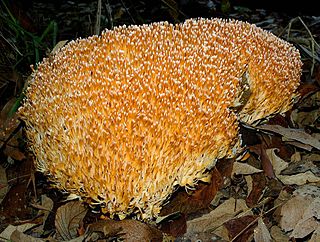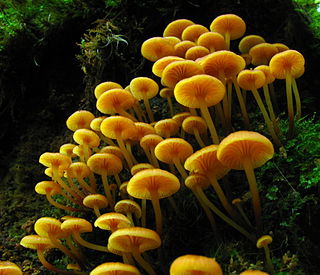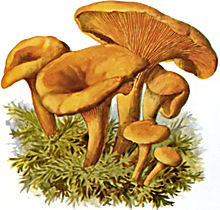
Diplocystaceae is a family of fungi in the Boletales order. The family was described by mycologist Hanns Kreisel in 1974.

Rhizopogonaceae are a family of fungi in the order Boletales. The family, first named and described by botanists Ernst Albert Gäumann and Carroll William Dodge in 1928, contains 2 genera and 151 species. The genus Fevansia, formerly thought to belong in the Rhizopogonaceae, was found to belong in the Albatrellaceae in a molecular phylogenetics study.

The Aphelariaceae are a family of fungi in the order Cantharellales. The family contains a small group of tropical and subtropical clavarioid fungi, but is not well characterized and has not been the subject of published research.

The Bankeraceae are a family of fungi in the order Thelephorales. Taxa are terrestrial, and ectomycorrhizal with plant species in families such as Pinaceae or Fagaceae. The family was circumscribed by Marinus Anton Donk in 1961. According to a 2008 estimate, the family contains 6 genera and 98 species.

The Hymenochaetaceae are a family of fungi in the order Hymenochaetales. The family contains several species that are implicated in many diseases of broad-leaved and coniferous trees, causing heart rot, canker and root diseases, and also esca disease of grapevines. According to a standard reference text, the family contains 27 genera and 487 species.
The Acaulosporaceae are a family of fungi in the order Diversisporales. Species in this family are widespread in distribution, and form arbuscular mycorrhiza and vesicles in roots. The family contains two genera and 31 species.

Hygrophoropsis is a genus of gilled fungi in the family Hygrophoropsidaceae. It was circumscribed in 1888 to contain the type species, H. aurantiaca, a widespread fungus that, based on its appearance, has been affiliated with Cantharellus, Clitocybe, and Paxillus. Modern molecular phylogenetic analysis shows that the genus belongs to the suborder Coniophorineae of the order Boletales.

Delicatula is a genus of fungi in the family Tricholomataceae. It was first described by Swiss mycologist Victor Fayod in 1889. The genus contains two widely distributed species.
Deigloria is a genus of agaric fungus in the family Marasmiaceae. Described by mycologist Reinhard Agerer in 1980, the genus contains 10 species that are widespread in neotropical areas. The generic name derives from the Latin words Deus (God) and gloria (glory).

Lactocollybia is a genus of agaric fungi in the family Marasmiaceae. The widespread genus contains 17 species, many of which are found in tropical areas.

Moniliophthora is a genus of fungi in the family Marasmiaceae. The genus was described in 1978 with M. roreri as the type species. This fungus, formerly known as Monilia roreri, causes frosty pod rot, a serious disease of Theobroma cacao.
The Gallaceaceae are a family of fungi in the order Hysterangiales, containing species found in Australia and New Zealand. The family contains three genera and 16 species.

Xeromphalina is a genus of fungi in the family Mycenaceae. The genus has a widespread distribution, and contains about 30 species.

Austropaxillus is a genus of fungi in the family Serpulaceae, containing nine species found in Australia, New Zealand and South America.
Stephanopus is a genus of fungi in the family Cortinariaceae. The genus, circumscribed by mycologists Meinhard Moser and Egon Horak in 1975, contains five species found in South America.
Dingleya is a genus of truffles in the Tuberaceae family. The genus contains seven species found in Australia. Circumscribed by James Trappe in 1979, the genus is named after New Zealand mycologist Joan Dingley.
The Cladochytriaceae are a family of fungi in the order Cladochytriales.
The Endochytriaceae are a family of fungi in the order Cladochytridiales. The family contains 10 genera and 56 species according to a 2008 estimate. It was circumscribed by mycologist Donald J.S. Barr in 1980.
Catenochytridium is a genus of fungi in the family Endochytriaceae. The genus contains six species known from Japan and North America.
Entophlyctis is a genus of fungi currently classified in the family Chytriomycetaceae. The genus, widespread in temperate regions and contains about 20 species.











